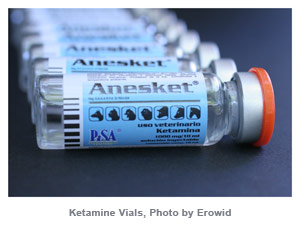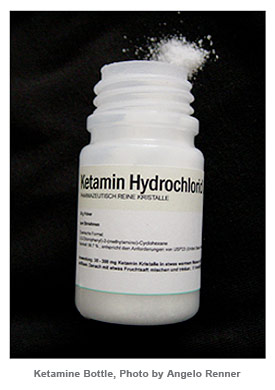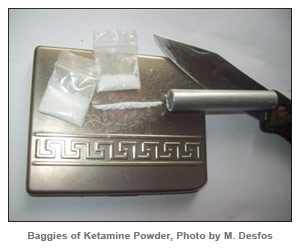KLUTS: Ketamine and Lower Urinary Tract Symptoms
v1.0 - Nov 2010
Erowid Extracts #19
Citation: Hanna J. "KLUTS: Ketamine and Lower Urinary Tract Symptoms". Erowid Extracts. Nov 2010;19:12-4. Online edition: Erowid.org/chemicals/ketamine/ketamine_article2.shtml
See also the companion article: Ketamine Use and Health 2010: Erowid Micro-Surveys
In 2007, medical journals began reporting cases of ketamine-associated ulcerative cystitis,1 a newly described bladder inflammation characterized by a number of lower urinary tract symptoms (LUTS) that include increased frequency of urination, urinary incontinence, pain during urination, passing blood in the urine, and reduced bladder size. Initial reports came from chronic recreational users of ketamine, but additional reports have since surfaced related to clinical use in the treatment of pain. So far, Erowid is not aware of any LUTS reports resulting from the use of ketamine as a surgical anesthetic, probably because this does not generally involve repeated use.
Recreational use of ketamine has risen in recent years, particularly in Asia. This has contributed to more hospitalizations of users, as well as to an increase in reports and discussion of LUTS as a potentially serious adverse effect for regular users of the drug. East Asian ketamine users seeking medical help have been fairly young; in one review of 233 cases of people who visited emergency rooms in Hong Kong after using ketamine, the median age was 22 years old and 12% of these patients reported some urinary tract symptoms.2 One article describing 59 case reports of ketamine-associated LUTS estimated that 30% of ketamine users might experience some "urinary symptoms",3 and others have repeated this estimate or projected a range of 20-30%.4,5 However, it is important to note that these estimates are based on hospital admissions and none of the authors provide any basis for extending their extrapolations to the larger general population of ketamine users. In a web survey conducted in October 2010 by Erowid, 3.6% of ketamine users reported that they had "probably" or "definitely" had bladder pain or urinary problems caused by their ketamine use (see Ketamine Use and Health 2010: Erowid Micro-Surveys).
These problems are surprising to the Erowid crew because, up until a few years ago, we had received no reports of such symptoms being associated with ketamine use. Although we have communicated with dozens of regular ketamine users over the years, including a number of daily and even hourly users, none of those people and none of the submitted experience reports before the mid-2000s described urinary tract problems. We asked ketamine expert Dr. Karl Jansen what he thought about ketamine-associated LUTS, and he replied: "It is a mystery to me also. Nobody I have ever spoken with has had such an issue, and I have spoken with some very heavy chronic users. There has been the mysterious 'K Pains', and it may be--given that they are unexplained--that these do arise in the urinary tract rather than the gastrointestinal system as has been assumed. In short, I know nothing about it beyond the recent reports, and have no ideas about it beyond the above."6
One theory is that something about ketamine has changed. Many countries have increased controls on ketamine during the last ten years, and this may have affected the quality or use patterns associated with the substance. Prior to 2000, most recreationally used ketamine was diverted from the pharmaceutical medical supply. An increase in clandestinely produced ketamine may have resulted in contaminated material, in different forms or isomers of the compound, or in changing patterns of use (presumably the decrease of the injectable liquid associated with the pharmaceutical supply has led to more insufflation worldwide). Any of these changes might explain the increased risk of LUTS. However, the fact that some case reports of LUTS are from patients who have been prescribed ketamine for medical use confounds this line of speculation. A few tests done on street ketamine believed to have been illicitly synthesized, rather than being diverted pharmaceutical product, found that the material contained only ketamine and traces of dimethyl sulfoxide (DMSO).1,7
Because there have not yet been any controlled studies or other work to show that the incidence of LUTS is unusually high among ketamine users compared to otherwise similar populations of non-users, it is not currently possible to say that ketamine use increases the risk of LUTS. Because some urinary tract symptoms are extremely common in the general population, there is the risk of mistakenly identifying ketamine as a cause by relying on case reports. Large surveys estimate the general rate of LUTS at around 50% for people under 40 years old and, in one survey of men and women over 40 years old, more than 70% of respondents reported at least some LUTS.8 However, in some of the reported cases the doctors assert that a "strong temporal association observed between the onset and cessation of ketamine use [...] implicates ketamine as a causal factor."1
The mechanism by which ketamine might cause the various symptoms of urinary dysfunction has not yet been established. Speculations from published case reports include the theory that ketamine and/or its metabolites, carried in the urine, exert a direct irritating effect on kidney or bladder cells, resulting in inflammation. Another theory proposes the possibility that ketamine and/or its metabolites compromise circulation in the bladder (and possibly the kidney) or decrease microvascular density. Case report authors have also proposed that an autoimmune reaction may play a role.1,9
Three chronic pain patients who developed LUTS were on prescribed oral doses of more than 800 mg administered over each 24-hour period.6 In another case, a 16-year-old chronic pain patient started showing LUTS after only 9 days on ketamine at 8 mg/kg per day; her symptoms improved when the dose was dropped to 6 mg/kg per day, and disappeared when the dose was dropped to 2 mg/kg per day. After having been off ketamine for a time, she started again at 5 mg/kg per day and the LUTS returned, but it disappeared when the dose was dropped to 3 mg/kg per day.10
One detailed case study included 59 street-ketamine-using patients with LUTS whose "duration of ketamine abuse" ranged from 6 months to 10 years;3 unfortunately, it did not present information about when the onset of symptoms occurred. Another study of 11 patients who had used ketamine for 1-4 years reported the onset of LUTS at 1-24 months, with daily doses ranging from 300 mg to 5 grams.4
However, in another case report, a 21-year-old male who had been experiencing LUTS for about nine months commented that his problems started right around the same time he began snorting ketamine "about twice a week".9 And in the case of a 25-year-old male who had been reconstituting powder and injecting it IV (not IM) 2-3 times a week, the LUTS showed up "just several days after the onset of ketamine use". The final verdict in this case was end-stage renal disease requiring regular hemodialysis.11 While no information is provided related to the quantity consumed in either of these cases, these use patterns fit more closely to the "weekend partier" than to the daily user, and may indicate that even non-chronic users of ketamine should be concerned about possible damage to their lower urinary tract.
Ketamine is considered by some recreational drug users to be a relatively "safe" drug, despite its reputation as insidiously addictive. It has historically been pharmaceutically pure and is usually taken in amounts much lower than those used to induce anesthesia in a clinical setting. Although fatal overdoses are rare, accidental deaths while under the influence of ketamine have occurred in otherwise healthy individuals. The latest information on ketamine-associated ulcerative cystitis may temper the idea that ketamine use won't cause any long-term health issues among those who avoid serious addiction.
It is worth noting again that some urinary tract symptoms are common even among non-ketamine users. In addition, the entire spectrum of symptoms described as being suspected to be caused by ketamine use doesn't occur in all ketamine users who report some LUTS. With proper treatment, most symptoms of ketamine-associated LUTS resolve after cessation of ketamine use, as long as it is confirmed that they are not caused by an infection (UTI) or sexually transmitted disease. It should also be pointed out that mainstream media coverage of this phenomenon could create an impression that the problem is larger than it is.
The wide dose-response range leading to documented cases of LUTS suggests that individual responses to ketamine may be idiosyncratic and unpredictable, making it unclear what level and frequency of use may lead to urinary problems. Nevertheless, frequent ketamine users may want to cut back on their use, and all ketamine users might want to moderately increase their intake of water and pay attention to even minor urinary symptoms.
In 2007, medical journals began reporting cases of ketamine-associated ulcerative cystitis,1 a newly described bladder inflammation characterized by a number of lower urinary tract symptoms (LUTS) that include increased frequency of urination, urinary incontinence, pain during urination, passing blood in the urine, and reduced bladder size. Initial reports came from chronic recreational users of ketamine, but additional reports have since surfaced related to clinical use in the treatment of pain. So far, Erowid is not aware of any LUTS reports resulting from the use of ketamine as a surgical anesthetic, probably because this does not generally involve repeated use.
Case Reports Aplenty
Recreational use of ketamine has risen in recent years, particularly in Asia. This has contributed to more hospitalizations of users, as well as to an increase in reports and discussion of LUTS as a potentially serious adverse effect for regular users of the drug.
New? Or Undetected?

|
One theory is that something about ketamine has changed. Many countries have increased controls on ketamine during the last ten years, and this may have affected the quality or use patterns associated with the substance. Prior to 2000, most recreationally used ketamine was diverted from the pharmaceutical medical supply. An increase in clandestinely produced ketamine may have resulted in contaminated material, in different forms or isomers of the compound, or in changing patterns of use (presumably the decrease of the injectable liquid associated with the pharmaceutical supply has led to more insufflation worldwide). Any of these changes might explain the increased risk of LUTS. However, the fact that some case reports of LUTS are from patients who have been prescribed ketamine for medical use confounds this line of speculation. A few tests done on street ketamine believed to have been illicitly synthesized, rather than being diverted pharmaceutical product, found that the material contained only ketamine and traces of dimethyl sulfoxide (DMSO).1,7
A Real Association?
Symptoms of LUTS sometimes improve or disappear entirely upon cessation of ketamine use, but not in all cases; in addition, it appears that permanent damage can be done to the bladder and urinary tract.
Mechanism Unknown

|
How Much, How Often?
Several of the published papers--often based on retroactive analysis of patient files--do not provide specifics related to the amount and frequency of dosing; nevertheless, they generally describe the recreational use as chronic. What constitutes chronic use? How much and how often? The journal articles that include information on frequency in their case histories of ketamine-associated ulcerative cystitis generally discuss daily use, which is also the frequency associated with patients taking ketamine for chronic pain.Three chronic pain patients who developed LUTS were on prescribed oral doses of more than 800 mg administered over each 24-hour period.6 In another case, a 16-year-old chronic pain patient started showing LUTS after only 9 days on ketamine at 8 mg/kg per day; her symptoms improved when the dose was dropped to 6 mg/kg per day, and disappeared when the dose was dropped to 2 mg/kg per day. After having been off ketamine for a time, she started again at 5 mg/kg per day and the LUTS returned, but it disappeared when the dose was dropped to 3 mg/kg per day.10
One detailed case study included 59 street-ketamine-using patients with LUTS whose "duration of ketamine abuse" ranged from 6 months to 10 years;3 unfortunately, it did not present information about when the onset of symptoms occurred. Another study of 11 patients who had used ketamine for 1-4 years reported the onset of LUTS at 1-24 months, with daily doses ranging from 300 mg to 5 grams.4
There are indications that higher doses, more frequent doses, and longer-term use can all cause more severe and less-reversible damage.
Prognosis
Symptoms of LUTS sometimes improve or disappear entirely upon cessation of ketamine use, but not in all cases; in addition, it appears that permanent damage can be done to the bladder and urinary tract. There are indications that higher doses, more frequent doses, and longer-term use can all cause more severe and less-reversible damage. In many of the case reports of ketamine-associated ulcerative cystitis, the medications used to alleviate symptoms were only partially or not at all successful, and the prognosis in advanced cases is dire.Not So Safe?

|
It is worth noting again that some urinary tract symptoms are common even among non-ketamine users. In addition, the entire spectrum of symptoms described as being suspected to be caused by ketamine use doesn't occur in all ketamine users who report some LUTS. With proper treatment, most symptoms of ketamine-associated LUTS resolve after cessation of ketamine use, as long as it is confirmed that they are not caused by an infection (UTI) or sexually transmitted disease. It should also be pointed out that mainstream media coverage of this phenomenon could create an impression that the problem is larger than it is.
The wide dose-response range leading to documented cases of LUTS suggests that individual responses to ketamine may be idiosyncratic and unpredictable, making it unclear what level and frequency of use may lead to urinary problems. Nevertheless, frequent ketamine users may want to cut back on their use, and all ketamine users might want to moderately increase their intake of water and pay attention to even minor urinary symptoms.
References #
- Shahani R, Streutker C, Dickson B, et al. "Ketamine-Associated Ulcerative Cystitis: A New Clinical Entity". Urology. 2007;69(5):810-2.
- Ng SH, Tse ML, Ng HW, et al. "Emergency Department Presentation of Ketamine Abusers in Hong Kong: A Review of 233 Cases". Hong Kong Med J. 2010;16(1):6-11.
- Chu PS-K, Ma W-K, Wong SC-W, et al. "The Destruction of the Lower Urinary Tract by Ketamine Abuse: A New Syndrome?". BJU Int. 2008;102(11):1616-22.
- Tsai TH, Cha TL, Lin CM, et al. "Ketamine-Associated Bladder Dysfunction". Int J Urol. 2009;16(10):826-9.
- Stewart R. Personal communication. Sep 2010.
- Storr TM, Quibell R. "Can Ketamine Prescribed for Pain Cause Damage to the Urinary Tract?". Palliat Med. 2009;23(7):670-2.
- Jansen K. Personal communication. Sep 2010.
- Coyne KS, Sexton CC, Thompson CL, et al. "The Prevalence of Lower Urinary Tract Symptoms LUTS in the USA, the UK and Sweden: Results from the Epidemiology of LUTS EpiLUTS Study". BJU Int. 2009;104(3):352-60.
- Ho CC, Pezhman H, Praveen S, et al. "Ketamine-Associated Ulcerative Cystitis: A Case Report and Literature Review". Malaysian J Med Sci. Apr-Jun 2010;17(2):61-5.
- Grégoire MC, MacLellan DL, Finley GA. "A Pediatric Case of Ketamine-Associated Cystitis (Letter-to-the-Editor RE: Shahani R, Streutker C, Dickson B, et al: Ketamine-Associated Ulcerative Cystitis: A New Clinical Entity. Urology 69:810-812, 2007)". Urology. 2008;71(6):1232-3.
- Huang Y-C, Jeng C-M, Cheng T-C. "Ketamine-Associated Ulcerative Cystitis". Tzu Chi Med J. 2008;20(2):144-6.


